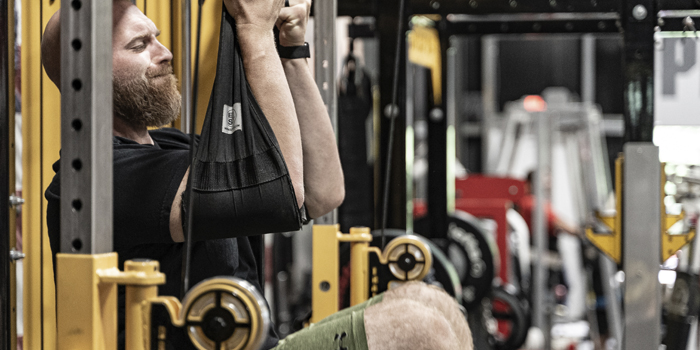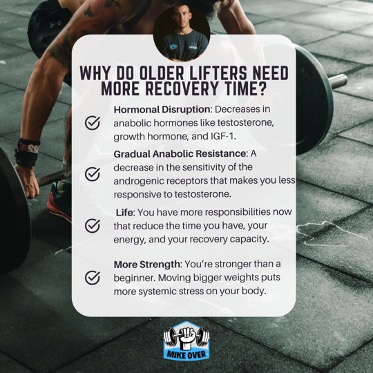
After 30, most of us men can no longer load up our gym bag with a day's worth of protein and clothes to head to our place of peace for two- to three-hour stints, let alone enjoying the extended care package of sauna and smoothie bar treatment.
We become working professionals, dads, and husbands, requiring an altered training program suitable for our new lifestyle.
Although training like a twenty-year-old at the age of 40 is nonsensical, it seems to be a tough pill to swallow for many men. Realize, the amount of stress and responsibility you have now would make the 20-year-old version of yourself NEVER want to grow up!
Changes Men Are Undergoing
Many men undergo deeper changes as they age and become fathers and adults. These changes make it more difficult to gain strength, build muscle, and lose fat.
Dads have higher levels of the hormone oxytocin. Also known as the "love" hormone, oxytocin is linked to maternal bonding and forging relationships—crucial components in successful relationships and parenting.
RECENT: The Real Reasons You Didn’t Reach Your Strength Potential
Studies indicate that men's elevated oxytocin and prolactin levels make fathers more alert, sympathetic, and responsive to infant cries than non-fathers. Higher prolactin levels in men likely contribute to child-caring behavior and the emotional traits that go along with it. These higher levels are also linked to decreased sex drive in parents. Interesting, yes, but something to think about as you try to pack on slabs of muscle.
Staggeringly, men's testosterone levels have dropped at alarming rates, declining by one percent per year since the 1980s. So men today have 20% less testosterone than men a generation ago.
Why Does All This Matter?
Older men and dads need more recovery time. To get the most out of your workouts, you need to make sure you get sleep, nutrition, hydration, and a proper warm-up. Without any of those, your body will not progress on a level optimally.
I hate to be blunt, but we can't get where you want if we're burning the candle at both ends. For this, try spending 10-15 minutes in the morning reflecting, maybe closing your eyes, and envisioning your day ahead and what you can do to be 1% better. Spend some quiet time showing gratitude, even if it's two minutes. Our lives are chaotic, so failing to do so will just increase the body's cortisol and stress.
Check this guide out below:

So How Should the Busy Man Train?
Training should be adjusted. I find more success with higher frequency and get five to six workouts a week that are only 40 minutes each. Many ask why five to six, and I always say busy men have problems with habits and consistency. Having a shorter session planned more often builds residual habits that stick and allows us to stimulate growth hormone and not overdo training stress to keep our nervous system in a sympathetic state.
A 2010 study analyzed training frequency and the anabolic response. Researchers found that repeated bouts of resistance exercise and protein ingestion trigger an anabolic response and growth.
I'm not saying this is the only way, but there is a reason for it and why busy men have better success on it. Hitting muscle groups multiple times a week can also increase an anabolic response to muscle protein synthesis.
I'm a fan of upper and lower splits and sticking to rep ranges six-12. I love telling my men to "feel the weight" rather than lifting with ego. You can't afford to be lifting so heavy you get hurt and can't help your wife with your crazy kids all week. Remember you have dad and business responsibilities.
If you like lifting heavy, try doing your main lifts later in your workouts after you are a bit more fatigued, so you are not pushing heavier weights and are hitting better bouts of mechanical tension with less dangerous weight loads.
Your body only knows tension, so feeling the muscles contract can be a much better benefit for the busy man.
Remember not to ditch cardio! It improves work capacity to enhance your strength training sessions, and it helps with nutrient transferring, so you better utilize proteins, carbs, and fats.
More aerobic work helps with energy production and signaling a better recovery rate. Also, no one likes feeling winded after chasing kids around the house one lap.
It won't "hurt your gains" if you time it right.
Check out this article from Jason Brown for three conditioning methods I like to use.
I think using these methods as metabolic finishers, GPP, cardia output, and HIIT or ATP-PC tend to be the best. Find what works and don't push thresholds weekly based on how you "feel." While higher intensity work helps burn more calories, it comes with a price tag of longer recovery and cortisol production, which needs to be properly planned. Hiring a coach to oversee your goals might be best, so you don't try to be Superman every week.
Don't be a dummy and pull the "I don't have time" card when it comes to mobility. Spend five minutes working on drills like this to keep your hips well oiled, so you don't hit a set of squats and wonder why your depth looks like you forgot what knee flexion was.
Things like 90/90 stretches, adductor rocks, banded kneeling hip flexor work, and heel clicks can be great starting places for most for some help.
Sample Weekly Routine for Men
What About Nutrition?
Your diet can't resemble that of a teenage kid, and you can't get hooked on the "bulking diet." You have no business bulking in your 50s, especially if you are over 20% body fat.
When you let loose on your diet, your belly notices.
Your mind isn't sharp because of the rewinding episodes of Elmo and five conference calls you had at work….
You just don't have the stress-free gym life you used to, so your priorities with training and nutrition also need to be adjusted.
Remember this, the newer you are to training and the heavier you weigh, the easier you will drop fat.
It's never a suggestion to try to drop fat and build muscle simultaneously. For most seasoned men, pick a goal and stick to it. Commit enough time to build muscle.
For context, please take a look at this quick chart from muscle-building researcher Lyle McDonald.
As a beginner, one-and-a-half to two-and-a-half pounds per month of lean muscle mass is the upper limit of how much muscle you can build.
If you're an intermediate lifter, meaning you've added significant strength and size already, fast results would be three-fourths to one-and-a-half pounds of muscle per month.
If advanced and spent years training hard, you're realistically looking at a quarter to three-fourths of a pound of muscle per month.
Stick to the basics for eating. Find your go-to meals and be consistent with them.
11 Diet Reminders for Men
- Drink a minimum of your body weight in ounces of water each day.
- Stick to single-ingredient foods. If you can't pronounce it, don't eat it. Better yet, stick to ingredient labels with five things or less.
- Don't overthink it, but be realistic. Don't head to the bar or new restaurant with your buddies every weekend and go to town with wings and fries if you are looking to get ripped.
- You need to lose FAT FIRST. Many guys think they can bulk and then get muscular to cut later but forget that they already are overweight. I would say 12-16% body fat is lean enough to add muscle. You also will respond better to insulin and have better testosterone levels to aid in building muscle.
- Commit to it! Don't play the "shiny object syndrome" and jump to the newest trend you see online. Eat in a 10-15% caloric surplus, but if you like being in a deficit during the week to enjoy the weekend a bit more, then go for it. Adjust to your lifestyle. Just remember how quickly calories can add up with your night out with friends at Buffalo Wild Wings.
- Try avoiding low carb or keto diets. While it's possible, it's not "optimal" for building muscle because recent research has shown that low carb and high-fat diets can inhibit mTOR (an anabolic hormone precursor for building muscle). It can also suppress appetite, and no man wants that.
- Try getting most of your carbs from things like sweet potatoes, rice, oats, and whole grains. While there is no magic number for how much, I like one-and-a-half to two grams per body weight for men. I tend to like getting a majority of my carbs around training windows, and it can be better for combatting cortisol, insulin, and speeding recovery.
- Get your hormones in check with quality fats from Omega-3 fatty acids. Stick to fish, nuts, and seeds. Researchers have found that eating around 0.8 to one gram of fat per kilogram of body weight is adequate for optimal hormone production, so try to stick to 20-30% of your total calories.
- Take creatine, vitamin D, fish oil, and magnesium. All have been highly effective to aid in building muscle. Shun away from silly testosterone boosters. If you can load up on those silly products but not take $200 to get blood work to check your levels, you have bigger problems.
- Eat your greens. Micronutrients matter, but supplement with a quality greens powder with an NSF stamp if you struggle to get them in daily.
- Adjust your nutrition to your lifestyle. You don't have to follow your best friend's low-carb plan. You also won't have time to cook gourmet meals daily. Look into meal services that make busy days easy and effortless.
Remember, getting strong and building muscle isn't as easy as losing fat. You have to commit to the process and understand that program hopping and having the "shiny object syndrome" will only leave you less motivated, overwhelmed, and stuck because you never know if you are cutting or gaining.
The busy man needs structure, dedication, and a hammer to pound in the basics.
Mike Over is a NASM master trainer and owner of Over-Achieve Fitness in Pennsylvania. He works with hundreds of everyday gym-goers and athletes of all levels.











I'm down to lifting twice per week with one lighter session of the four main power lifts (3-5 sets of 6-8 reps) and then a heavier session of 1-3 sets of 1-3 reps for the same lifts, or a mix of strongman events that hit my whole body. And only one assistance exercise per session. Training any more than this and I simply do not recover, despite giving it a lot of attention.
I have never been injured lifting heavy weights for low reps. All of my injuries have come during high-rep lifting, so I gave it up in my mid-40's and haven't been injured since. The author's advice to perform heavy lifts after pre-exhausting muscles required for stability seems ludicrous for older lifters as our tendons become less flexible with age.